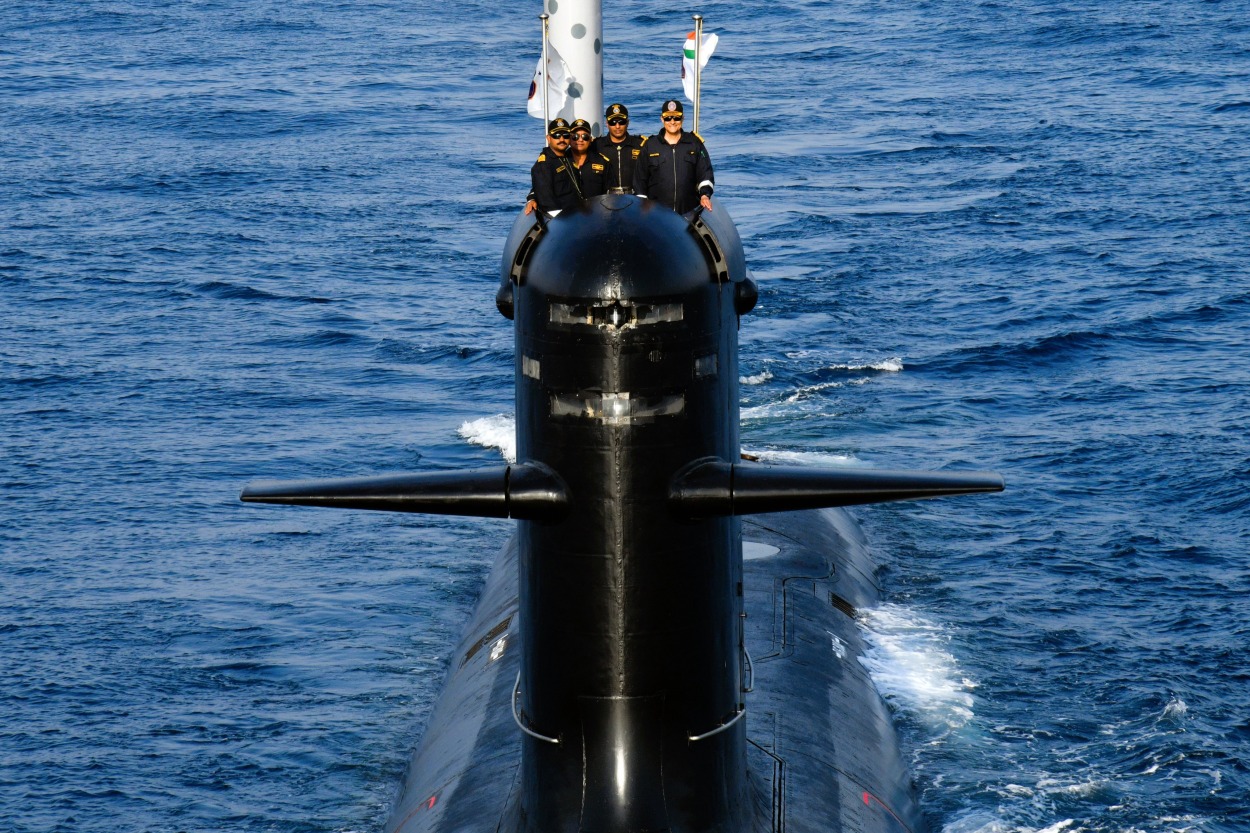India’s 3rd Nuke-Powered Submarine Spotted In Satellite Image; ‘Nuclear Triad’ Bolstered Amid China Threats

With an eye on China, India has been bolstering its military capabilities. In line with this, it launched its third indigenous nuclear-powered attack submarine (SSBN) in 2021.
The latest satellite imagery showed the extended nuclear submarine, codenamed S-4, underlining the possibility that it has already been inducted into the Indian Navy.
Satellite imagery taken at the outer dry deck of the secretive Ship Building Centre (SCB) in Visakhapatnam shows S-4 (the third Arihant-class SSBN) along with two of its predecessors.
The Launch tubes are visible in the image, and the submarine will be able to carry twice the number of submarine-launched ballistic missiles than the previous iteration of the Arihant class submarines.
The S-4 submarine is expected to have K-4 submarine-launched ballistic missiles with a 3500-kilometer range. The S4 and S4* are expected to be fitted with K-4 missiles. The need for long-range submarine-launched missiles corresponds to the increasing tensions in the Indo-Pacific region.
The K-15 missiles fitted on INS Arihant have a range of 750 km, which is woefully short of hitting anything significant in China, which is currently a prime adversary for India.
Even in a conflict with Pakistan, it would only have targets within its range in the south of the country. These are the first indigenously developed short-range submarine-launched ballistic missiles (SLBMs).
One of the big challenges in the sea leg of nuclear deterrence is that an underwater vertical launch system is among the most sophisticated and complex weapons since it demands stability, speed, and accuracy in two mediums—water and atmosphere.
The induction of S-4 will greatly boost India’s nuclear deterrence. The lack of at least three operational submarines means that the submarines are primarily in and out of the harbor without maintaining constant nuclear deterrence. So far, India had two nuclear-powered ballistic submarines (SSBNs) dubbed Advanced Technology Vessels (ATV). The first of these two is S2 (INS Arihant) and S3 (INS Arighat).
Only China has SSBNs in the Indian neighborhood. These have been deployed in the past for “counter-piracy patrols” off the east coast of Africa. However, Chinese anti-submarine warfare is in a nascent stage.
Given the threat assessment for India, SSBN promises a guarantee of survivability of nuclear retaliatory capability. With its long coastlines and peninsula, the SSBNs can remain hidden in ocean depths during the conflict to ensure the survival of second-strike capability.
“For nuclear deterrence, one submarine always needs to be on patrol. If Arihant is in and out of the harbor, it is not exactly a deterrent,” an Indian Navy officer told the EurAsian Times. “We need 3-4 SSBNs so we can keep one on patrol when one may be in port, one going for patrol, and one coming back,” he explained.
Buttressing his point, the officer referred to 52 years of Continuous Sea Deterrent (CASD), the UK’s longest sustained military operation ever. “If one cannot sustain it, it is hardly a deterrence,” the officer concluded.
In 2021, India quietly launched the yet-to-be-christened S-4 SSBN. British publication Janes reported on December 29, 2021, that S4 was launched on November 23 and had been ‘relocated’ to near the ‘fitting-out wharf’ that was presently occupied by INS Arighat, the second such nuclear-armed missile submarine.
The British publication further reported that satellite imagery had confirmed that at 7,000 tonnes, the S4 SSBN was ‘slightly larger,’ with a load water line measurement of 125.4m compared with 111.6m of the 6,000-tonne INS Arihant, the lead boat in this class. It categorized the S4 – and successive boats – as ‘Arihant-stretch’ variants.
The first indigenous submarine, INS Arihant, is a 6,000-ton ship powered by an 83 MW pressurized light water reactor (PWR) fuelled with enriched Uranium. It is 110 meters long with an 11-meter-wide beam and can travel up to 24 knots underwater.
INS Arihant, the first indigenous SSBN, was launched in 2009 and commissioned in 2016. In November 2019, INS Arihant completed its first deterrence patrol. The Indian government announced the establishment of the country’s “survivable nuclear triad”—the capability to launch nuclear strikes from land, air, and sea platforms.
INS Arihant is a technology demonstrator and an achievement for the Indian indigenization program. When the ATV was involved in an accident in 2017, India had no nuclear triad.
Making Indian Nuclear Deterrence Credible
In case of a nuclear conflict, the highest level of survivability lies with equipping nuclear-powered submarines with ballistic missiles with sufficient ranges. Since the submarine-launched ballistic missile first came into being, it has been considered the most survivable delivery system, as ocean depths remain opaque to a large extent.

A US nuclear submarine captain described the American Polaris submarine as “an extremely survivable assured capability that the Soviets knew they could not destroy and knew if they conducted a first strike, that system would someday be available to retaliate.
It might take some time to get the message to them from a destroyed national headquarters, but someday, the missile warheads would come raining in, and they would pay the price.”
India has a ‘no first use’ policy when it comes to nuclear weapons. A country needs the invulnerable second-strike capability that SSBNs give. In that sense, INS Arihant is a technology demonstrator.
The Indian Project to build a credible nuclear deterrence has been shrouded in secrecy since its inception. As India realized its goal to operate an SSBN with the help of Russian aid, it gained experience operating a nuclear-powered submarine leased from Russia.
To make the sub-surface arm of India’s nuclear triad pack more punch, India has been working on getting more SSBNs and SLBMs with greater range.
The first two SSBNs, the Arihant and the Arighat, were deficient in this respect as they only carried the relatively short-range K-15 submarine-launched ballistic missiles (SLBMs), though they can reportedly also accommodate four K-4 longer-range missiles. The K-15 has a range of only 750 kilometers, which is insufficient to target China from the Bay of Bengal.
In 2023, India tested its nuclear-capable K-4 submarine-launched ballistic missile with a strike range of 3,500 km twice a week. The missile was test-fired from an undersea platform in the shape of a submersible pontoon off the coast of Andhra Pradesh. The test demonstrated the missile’s capability to emerge from underwater and undertake its parabolic trajectory.
Once the K-4 missiles are inducted, they will help India bridge the gap with China, which has SLBMs with a range of over 5,000 kilometers. The K-4 missiles will be followed by the K-5 and K-6 missiles in the 5,000-6,000 km range.
- Questions and Answers
- Opinion
- Story/Motivational/Inspiring
- Technology
- Art
- Causes
- Crafts
- Dance
- Drinks
- Film/Movie
- Fitness
- Food
- Jeux
- Gardening
- Health
- Domicile
- Literature
- Music
- Networking
- Autre
- Party
- Religion
- Shopping
- Sports
- Theater
- Wellness
- News
- Culture
- War machines and policy


